NEWS directly from camp for the period 27/4 - 6/5 2015
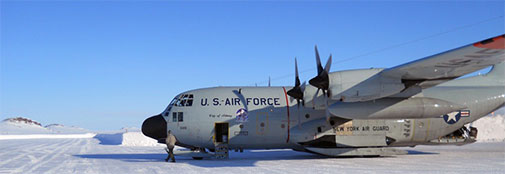
The Hercules airplane carrying the initial team and cargo shortly after landing in Mestersvig
MONDAY APRIL 27th
Just after noon, the initial team of eigth left Kangerlussuaq by ski-equipped Hercules airplane. We were received by the two servicemen at the Danish Defence’s guard at Mestersvig on the East Greenland coast, and the plane returned to Kangerlussuaq.
Many thanks to the 109th for again providing crucial airlift support to our projects.
We were installed at the base and spent most of the rest of the day unpacking our cargo and sorting it according to priorities.
All food was brought to the canteen building, including the food going to the field, as polar bears roam in the area. For the same reason, we all carry radios whenever we are outside, even when walking the 15 meters from the barracks to the kitchen.
TUESDAY APRIL 28th
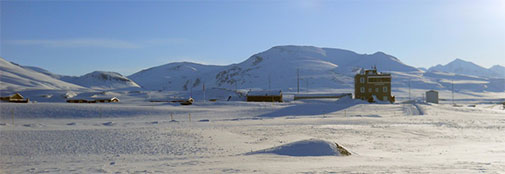
The Mestersvig base buildings. The staff lives in tower and we were accommodated in the barracks to the left. There are splendid views to mountains in all directions.
Due to unstable weather in West Greenland, we could not receive the next flights with cargo from Kangerlussuaq, so we focused on finalizing and optimizing the cargo for the first mission to the Renland ice cap, the so-called “radar camp”, aiming at locating the optimal drilling location.
We also shovelled a fair bit of snow to access base facilities, as we are visiting the base relatively early in the season and want to cause as little extra work for the base staff as possible.
The Twin Otter aircraft that will be used for the put-in stopped over in Mestersvig for refuelling, and we had a chance to plan and coordinate Wednesday’s mission with the pilots.
Finally, we had time to fully appreciate the splendid views over the surrounding mountains, Stauning’s Alps, and interact with the four sled dogs King, Balder, Gorm, and Robin (but not Muglug) that live on the base. We had a cosy evening exchanging stories with the Mestersvig base staff after another great meal cooked by our camp cook Sarah.
As on Monday, weather was fantastic, with clear skies, no wind, and day temperatures from -17 to -9°C.
WEDNESDAY APRIL 29th
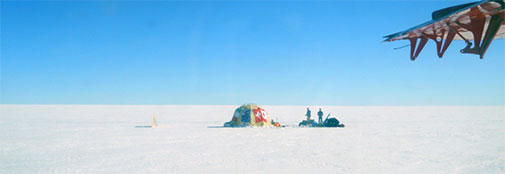
The view through the window from the second Twin Otter airplane. It was a great welcome to see the main tent decorated with flags from the project partner nations.
In the morning, during the formal inspection of our safety, communications, and camp equipment, we found our cargo slightly rearranged. A closer look revealed that some plastic wrapping had been torn to pieces and a few items had been pushed around … and that a large bit of the seat of our skidoo was missing! Apparently, a polar bear had inspected our equipment during the night and decided that the tastiest bit was the leather seat. We hereby apologize to our mechanic who at earlier occasions has expressed frustration that scientists are not taking good care of their vehicles, but feel that we are not really to blame this time.
We also found bear tracks around the kitchen building. We all got a little exited but were assured by the base staff that meeting polar bears on the Renland ice cap is very unlikely (but we do carry riffles anyway).
The Twin Otter arrived, and we loaded it with all the food, tents, safety equipment, communications equipment, and the first two radar team members: Trevor DB Popp and Christian “Cyber-Jesus” Panton. The plane took off from Mestersvig 12:37 and landed about 35 minutes later on the pristine Renland ice cap.
The flight was amazingly beautiful: Extremely steep and pointy mountains dominate the area around Renland, and the valleys are filled with outlet glaciers and ice streams in all shapes.
Just one hour after leaving Mestersvig, the plane was airborne again from Renland, and upon its return, it was loaded with a skidoo, a large Nansen sled, the radar equipment, and the last two members of the put-in crew: Iben RF Koldtoft and Sune “sourdough” Olander Rasmussen.
We would like to express our sincere thanks to the Mestersvig base crew for their help and advice and for making the transition to the East Coast so comfortable.
When the second plane arrived at 16:17, the main tent was up and basic facilities had been established.
The camp sits in a saddle between two domes, and the tall and incredibly steep mountains around us are therefore only barely visible from the camp.
The surface is smooth and firm, and the Twin Otter was able to land and take off without any problems, leaving only about 10 cm deep tracks. The payloads (including personnel) were approx. 850 and 1000 kg, respectively. It is a privilege to work with the Norlandair Twin Otter pilots: It is clear that they have a lot of experience working under field conditions, and we depend on their services.
For the rest of the day, we were busy setting up camp: we put up the personal sleeping tents and the “RECAP Press Office” (a separate tent for the loo), arranged cargo, started the generators, cooked our warm first meal, and made the first attempt at establishing satellite data and phone lines. We were not successful with the latter, and we therefore still rely on handheld Iridium phones for communication, which works fine but has very limited data transfer capabilities.
Temperature at arrival -17°C, dropping to between around -30°C at night. The sun almost sets at night, resulting in a long, cold, sunset/rise with beautifully coloured skies. No wind of significance.
THURSDAY APRIL April 30th
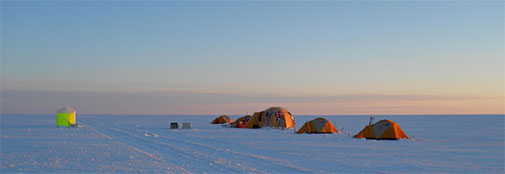
Evening view over camp. “The Press Office” to the left, and to the right the main tent with two personal tents on each side.
The main task today was to get ready for radar measurements.
On the inbound flight, we had observed crevasses at the outskirts of the area that we were considered making radar measurements in. We therefore decided to reduce the survey area, and started the morning with crevasse safety training followed by a survey along the perimeter of the reduced survey area. Meanwhile, radar equipment was assembled, and in the afternoon, we mounted the equipment on the sled and made the first measurements.
The initial processing shows a clear signal from the bedrock at a depth of approximately 530 meter at the base camp location, and resolvable internal layering down to about 400 meter. Further testing will take place tomorrow, hopefully followed by the first real measurements.
We suspect that vibrations in the radar antenna is causing some noise on the data, and we will work of stabilizing them tomorrow.
We also made a more thorough test of the VSAT satellite communications system, but failed to pick up a sufficiently strong signal. We will continue testing the system when time allows: Our priority is to get results from the radar measurements in order to support the selection of the best spot for the ice core drilling.
Temperature up to around -15°C, dropping to about -30°C at night. Temperature in the main tent above freezing most of the day, up to 12°C in the evening when we cook and all stay inside. No wind of significance.
FRIDAY MAY 1st
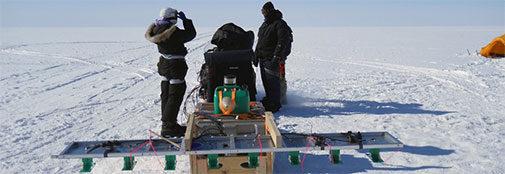
The radar setup mounted on a Nansen sled and dragged behind a skidoo. Note the improvized stabilizing devices (including a blue plastic soup plate) wedged underneath the left wooden beam. Iben and Christian are ready to take off, dressed in many layers of clothing and safety equipment in case they encounter crevasses.
Night temperatures reached -31°C, and the team took a little time to get going this morning.
After butter-toasted English muffins and coffee, we were back in business and directed our full attention to the radar setup that has been generously provided by our partner CReSIS, Centre for Remote Sensing of Ice Sheets, Kansas, US.
The radar is a modified accumulation radar system, originally intended to map internal layers for snow accumulation studies down to a depth of several hundred meters. It operates in the 600-900 MHz band and has a 10 W peak power. CReSIS has modified the setup to focus on the mapping of deep internal layers and the bedrock from surface-based surveying.
Based on yesterday’s observations, we decided to dampen the vibrations in the antenna ground plane. We accomplished this using a combination of cargo straps, foam from a riffle case, gaffers tape, string, wire strips, a soup plate, and a wooden spoon. After warming up the system, we made a 9 km run between the two neighbouring domes. Data processing took place during lunch, and showed clear internal reflections but also steep and rough terrain in some places … not really a surprise given the pointy mountain terrain around us.
In the afternoon, two teams surveyed a total of 26 km. By 8pm, temperatures were dropping and a light ground haze was developing. We decided to stop for the day and covered the radar sled with a tarpaulin to protect the connectors from rime and diamond dust: tiny ice crystals that fall slowly from the sky.
For dinner, we had our first serving of freeze-dried food. Not a pleasure! We have two more lunches of “real food”, brought precooked from Mestersvig, but from now on we will only eat these for lunch as they require a lot more dishwashing, which is bothersome at the low evening temperatures. We do still have chocolate and energy bars for a few months, though.
Radar data processing started after dinner and continued into the late evening. We have now covered the grid around the current camp, and will expand the grid south- and east-wards and fill in missing segments tomorrow.
SATURDAY MAY 2nd
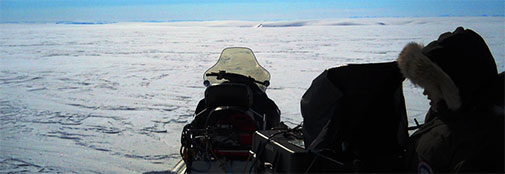
Iben inspecting the radar data capture computer under the black “hood” during measurements a few km south of camp. In the background, one can just see beginning of one of the ice streams that drain the Renland Ice Cap.
Weather was still calm, making skidoo driving relatively pleasant, while wind was forecasted for the evening, so we therefore focused entirely on completing the main radar survey grid, obtaining about 40 km of radar profiles.
Surveying a radar line east of camp, Trevor and Christian found and tentatively named the Renland Eastern Giant Ice Stream, REGIS: The feature is about a kilometre wide and drains the central part of the East Renland ice cap and is characterized by very flat bedrock and surface geometry.
We get impressively accurate weather forecasts from expedition weather specialist Marc De Keyser, and he forecasted winds picking up in the evening and a small risk of strong winds during night.
In the afternoon, while Christian processed the radar data, the rest of the team prepared the camp for windy conditions: we tied down all light items and built snow walls around the tents to break the wind. The wind picked up during the evening, but the wind speeds never got really high.
We were all tired, so the Saturday night party never really took off: After a splendid meal of fried meat balls with cheese-enriched mashed potatoes, we sank into our camping chairs (some of them still intact) with a cup of rum, telling stories about past field seasons.
When the radar data processing was complete, we convened the first pan-Renlandic Open Science Conference, where the invited keynote speaker Christian presented the newest results on the internal layering of the Renland Ice Cap. After a lively plenary discussion, the most promising area for a deep drilling site was agreed upon, and we decided to map out the layering in a “microgrid” Sunday in order to find the optimal place to drill within the identified area.
Temperatures during the day up to -16°C, during the night -27°C. Wind from N and NW picking up from late afternoon.
SUNDAY MAY 3rd
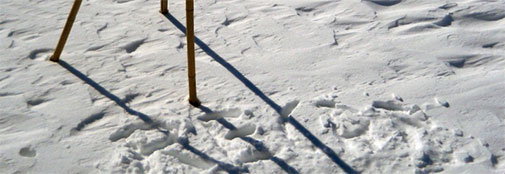
Three bamboo sticks and the word “RECAP” written in the snow mark the proposed drilling location
The wind speed at 10 am was about 7 m/s, so Iben and Christian had a cold time covering the 125-meter spaced radar grid lines around the proposed drill site.
Based on the processed data, we decided to recommend drilling at a site about 500 m SE of the radar camp, where we expect an ice thickness of between 500 and 600 meters and 25-30 meter of glacial ice located well above bedrock. With some luck, undisturbed ice from the previous interglacial could also be hiding in the lower meters!
The team immediately went by skidoo to the location and marked it by three bamboo sticks. We then marked up the skiway and apron for the up to five Bassler flights expected tomorrow.
To mark that the radar team has fulfilled its mission to locate the drilling location, the team took a little excursion to the REGIS location on East Greenland to admire the views, the topography, and make a toast in Gammel Dansk.
Back at the camp, packing started, as the radar equipment is planned to leave camp tomorrow. We also expect to say goodbye (or rather “see you later”) to Iben, who will go to Constable Point with the Bassler. We will miss her in camp, but do envy her chance to get a shower soon …
The daily reports from the period since we left Kangerlussuaq (April 27th – May 3rd) will leave camp on a USB stick with the Bassler flight tomorrow. We still have no data connection in camp, but hope to have established a connection within the coming week. Until then, we hope to be able to provide daily reports via plane-carried USB sticks with 1-2 days delay provided that the weather stays good.
Weather: Winds of 7 m/s dropping in the morning to 3 m/s at 9 pm. Temperatures as usual: -21°C at 6am, maximum temperature about -16°C in the early afternoon, dropping to -22°C at 9pm. Clear skies over Renland, but increasing cloud cover to the west during afternoon and evening, slowly approaching.
MONDAY MAY 4th
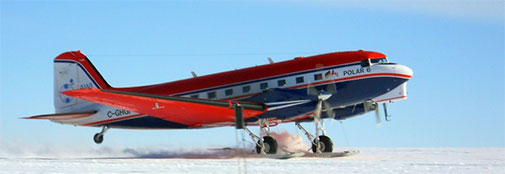
The Bassler aircraft “Polar 6” landing on the RECAP skiway.
In the morning, we received the first Bassler flight from Constable Point on the newly established skiway.
The first mission was mainly a test of the skis that had just been mounted, and carried a light load of much-needed skidoo and generator fuel and the first wood for construction of the main RECAP camp which will consist of drill tent, main tent (with kitchen), ice core storage freezer (as it may get relatively warm from an ice core perspective at the end of the season), generator tent, doctor’s tent, and personal tents.
The Bassler “Polar 6” is a wonderful and very classy airplane, based on an original DC-3 model that is more than 60 years old, equipped with modern high-yield engines, making it a powerful workhorse and logistics lifeline for our camp. The plane is owned by the German RECAP partner institution AWI (the Alfred Wegener Institute) and is operated in a very friendly and professional way by crew from Ken Borek Air in Canada.
We received another three missions with full loads during the day. Both Iben and Christian left for Constable Point after delivering great radar campaign. The current camp can support 4-5 people, and we welcomed Dennis Vistisen from Mestersvig and Simon Sheldon from Constable Point.
Most of the day was spent organising the incoming cargo and packing the radar and VSAT equipment that was returned to the coast.
Weather: Variable and light winds from northerly directions. Day temperatures a little warmer than usual: maximum temperature -15°C, minimum night temperatures -29°C. Mostly clear skies with patches of high thin clouds.
TUESDAY MAY 5th
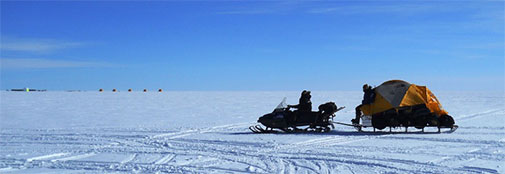
Bags with polar gear and personal equipment on the sled with a tent and a team member on top. In the background the main RECAP camp, located a little more than 500 m away from the radar camp: This is the same distance as the length of the core we hope to drill over the next two months.
We received a Bassler flight in the morning, bringing timber and ice core boxes.
We also started assembling the main tent that will house the kitchen and dining/living area. It’s the only fully heated tent in camp, and we need to have this tent up before we can safely accommodate a larger team.
Unfortunately, we had to cancel the day’s planned flights from Mestersvig due to fog, and we cannot get further with the main tent before we have received more tent parts from Mestersvig.
After organising the incoming cargo, we instead erected the generator tent and made a floor out of compressed snow and plywood.
After lunch, we decided to spend the afternoon moving the tents from radar camp to the main RECAP camp, and nothing is now left at the old campsite except an uneven snow surface and a little yellow area.
We managed to move the tents on the skidoo sled without disassembling them, which helped us quickly establishing the main camp.
In addition to the doctor’s tent (which is our temporary kitchen and living tent until the large main tent is complete), we have erected 9 personal tents and arranged most of the cargo so that we are ready to either receive more flights tomorrow or spend the day preparing the foundations for the drillers’ tent in case weather still does not allow flights to Mestersvig.
Weather: Due to the camp movement, we did monitor temperatures during the day, but morning and evening temperatures have been as usual. At the time of writing (10:30 pm), the outside temperature is -25°C and the temperature in the living tent is -13°C and quickly dropping. Winds have increased during the day from 5 to 10 m/s from N and NW.
EXTRA - 0505 2015 Mestersvig

A visitor to Mestersvig...
After successfully fighting off our polar bear nemesis each night, we received one Herc flight yesterday with the balance of the RECAP cargo from Kanger as well as our first Polar 6 AWI Basler flight to RECAP.
Dennis and Simon joined the RECAP camp while Bruce migrated from Constable Point to Mestersvig. We still have ~14,000 kg of cargo to shuttle to the RECAP camp via Basler from Mestersvig.
Weather this morning is foggy which may impact Basler flights. We expect it to clear later this morning or early afternoon. Temps are -15°C, no wind.
Current Mestersvig team is:
Emily, Bruce, Sarah and Todd accompanied by two “Owls” (Kennet and Michael) and four sled dogs (Bella, King, Robyn and Gorum).
WEDNESDAY MAY 6th
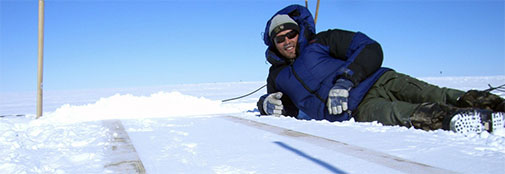
Chief driller Trevor resting after a job well done: The compacted snow holds the two beams in place that constitute the foundation of the deep ice-core drilling setup.
The morning weather report from Mestersvig meant that the planned flight was postponed.
While waiting for news on the flight plans, we started the day with pancakes and coffee. Realizing that we would probably not get any of the much-awaited parts for the main tent parts flown in today, we worked on camp infrastructure instead.
Simon made the fuel and exhaust setups and started up the generators (after making a few low-temperature adaptations) and worked on the wiring of camp and the Iridium data system, that we hope to get going.
Trevor and Dennis made the foundations for the drill setup: wooden beams were “cemented” into reworked compressed snow, and when the snow sinters, the beams will support the drill tower and winch.
Sune was today’s house mouse: apart from cooking, cleaning, and magically transforming snow into water, he cleaned up in camp, so that everything is organised and ready for more cargo, hopefully tomorrow.
In the evening, we secured our empty light-weight ice-core boxes against the wind, and went indoors for our last supplies of real food cooked by our camp cook and brought in Monday from Mestersvig. Until next plane from Mestersvig, all warm food will be from freeze-dry, which will just make butter-toasted bagels and pancakes even more popular …
Weather: Temperatures as normal: from -28⁰C to -16⁰C. Winds from N-NW of more than 5 m/s all day, peaking at 8 m/s in the late afternoon and early evening.
| ← Previous entry | Next entry → |
